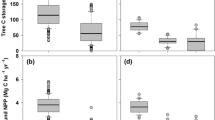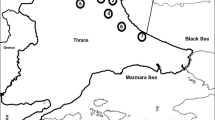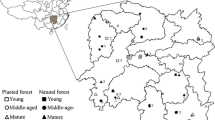Abstract
The pattern of carbon (C) allocation across different stages of stand development of Chinese pine (Pinus tabulaeformis) forests is poorly documented. In order to understand the effects of stand age on the C pool of the Chinese pine forest ecosystem, we have examined the above- and belowground C pools in three differently aged stands of Chinese pine in the northern mountains of Beijing, China, by plot-level inventories and destructive sampling. Our results suggest that tree branch and foliage biomass should be estimated by age-specific equations. Reasonably accurate estimates of tree stem, tree root, aboveground, and total tree biomass in a Chinese pine forest at different development stages were obtained using age-independent allometric equations from tree diameter only. The ratio of belowground to aboveground tree biomass was relatively constant with stand aging, remaining around 21 %. The contribution of aboveground tree biomass C increased from 21 % of the total ecosystem C in a 25-year-old stand to 44 % in a 65-year-old stand, subsequently falling to 41 % in a 105-year-old stand, while the contribution of mineral soil C decreased from 64 % of the total ecosystem C in 25-year-old stand to 38 % in a 65-year-old stand, subsequently increasing to 41 % in a 105-year-old stand. The C stock of the total ecosystem and its aboveground tree, tree root, forest floor, and mineral soil components continuously increased with stand ageing, whereas the C stock of the understory showed a declining trend and contributed little to the total site C pool.






Similar content being viewed by others
References
Bert D, Danjon F (2006) Carbon concentration variation in roots, stem and crown of mature Pinus pinaster (Ait.). For Ecol Manag 222:279–295
Chen L, Ren J, Bao X, Chen Q, Hu Y, Miao Y, Li Y (1984) Studies on the sociological characteristic and biomass of pine plantation on Xishan in Beijing. Chin J Plant Ecol 8:173–181
Chen L, Chen Q, Bao X, Ren J, Miao Y, Hu Y (1986) Studies on Chinese arborvitae (Platycladus orientalis) forest and its biomass in Beijing. Chin J Plant Ecol 10:17–25
Chen W, Chen J, Liu J, Cihlar J (2000) Approaches for reducing uncertainties in regional forest carbon balance. Glob Biogeochem Cycles 14:827–838
Davis MR, Allen RB, Clinton PW (2003) Carbon storage along a stand development sequence in a New Zealand Nothofagus forest. For Ecol Manag 177:313–321
Dieter M, Elsasser P (2002) Carbon stocks and carbon stock changes in the tree biomass of Germany’s forests. Forstwiss Cent 121:195–210
Dixon RK, Brown S, Houghton RA, Solomon AM, Trexler MC, Wisniewski J (1994) Carbon pools and flux of global forest ecosystem. Science 263:185–190
Fang J, Chen A, Peng C, Zhao S, Ci L (2001) Changes in forest biomass carbon storage in China between 1949 and 1998. Science 292:2320–2322
Fang JY, Tang YH, Son Y (2010) Why are East Asian ecosystems important for carbon cycle research? Sci China Life Sci 53:753–756
Farley KA, Kelly EF, Hofstede RGM (2004) Soil organic carbon and water retention after conversion of grasslands to pine plantations in the Ecuadorian Andes. Ecosystem 7:729–739
Gibbs HK, Brown S, Niles JO, Foley JA (2007) Monitoring and estimating tropical forest carbon stock: make REDD a reality. Environ Res Lett 2:1–13
Gower ST, Gholz HL, Nakane K, Baldwin VC (1994) Production and carbon allocation patterns of pine forests. Ecol Bull 43:115–135
Grünzweig JM, Gelfand I, Yakir D (2007) Biogeochemical factors contributing to enhanced carbon storage following afforestation of a semi-arid shrubland. Biogeosciences 4:891–904
Guo H, Wang B, Ma XQ, Zhao GD, Li SN (2008) Evaluation of ecosystem services of Chinese pine forests in China. Sci China Life Sci 51:662–670
Houghton RA (2003) Why are estimates of the terrestrial carbon balance so different? Global Chang Biol 9:500–509
International Panel on Climate Change (IPCC) (2007) Climate change 2007: synthesis report. Contribution of Working Groups I, II and III to the Fourth Assessment Report of IPCC. IPCC, Geneva
Kolari P, Pumpanen J, Rannik Ü, Ilvesniemi H, Hari P, Berninger F (2004) Carbon balance of different aged Scots pine forests in Southern Finland. Global Chang Biol 10:1106–1119
Krause H (1998) Forest floor mass and nutrients in two chronosequences of plantations: jack pine vs. black spruce. Can J Soil Sci 78:77–83
Law BE, Sun OJ, Campell J, Van Tuyl S, Thornton PE (2003) Changes in carbon storage and fluxes in a chronosequence of ponderosa pine. Global Chang Biol 9:510–524
Lemma B, Kleja DB, Nilsson I, Olsson M (2006) Soil carbon sequestration under different exotic tree species in the southwestern highlands of Ethiopia. Geoderma 136:886–898
Li X, Yi MJ, Son Y, Park PS, Lee KH, Son YM, Kim RH, Jeong MJ (2011) Biomass and carbon storage in an age-sequence of Korea pine (Pinus koraiensis) plantation forests in central Korea. J Plant Biol 54:33–42
Litton CM, Ryan MG, Knight DH (2004) Effects of tree density and stand age on carbon allocation patterns in postfire lodgepole pine. Ecol Appl 14:460–475
Liu GS (1996) Soil physical and chemical analysis and description of soil profiles. Standards Press of China, Beijing
Lorenz K, Lal R (2009) Carbon sequestration in forest ecosystems. Springer SBM, Dordrecht
Mao R, Zeng D-H, Hu Y-L, Li L-J, Yang D (2010) Soil organic carbon and nitrogen stocks in an age-sequence of poplar stands planted on marginal agricultural land in Northeast China. Soil Plant 332:277–287
Martin JL, Gower ST, Plaut J, Holmes B (2005) Carbon pools in a boreal mixedwood logging chronosequence. Global Chang Biol 11:1883–1894
Mund M, Kummetz E, Hein M, Bauer GA, Schulze E-D (2002) Growth and carbon stocks of a spruce forest chronosequence in central Europe. For Ecol Manag 171:275–296
Noh NJ, Son Y, Lee SK, Seo KW, Heo SJ, Yi MJ, Park PS, Kim RH, Son YM, Lee KH (2010) Carbon and nitrogen storage in an age-sequence of Pinus densiflora stands in Korea. Sci China Life sci 53:822–830
Paul KI, Khanna PK, Polglase PJ, Nyakuengama JG, Khanna PK (2002) Change in soil carbon following afforestation. For Ecol Manag 168:241–257
Peichl M, Arain MA (2006) Above- and belowground ecosystem biomass and carbon pools in an age-sequence of temperate pine plantation forest. Agric For Meteorol 140:51–63
Peichl M, Arain MA (2007) Allometry and partitioning of above- and belowground tree biomass in an age-sequence of white pine forests. For Ecol Manag 253:68–80
Pregizer KS, Euskirchen ES (2004) Carbon cycling and storage in world forests: biome patterns related to forest age. Global Chang Biol 10:1–26
Ren H, Chen H, Li Z, Han W (2010) Biomass accumulation and carbon storage of four different aged Sonneratia apetala plantation in Southern China. Soil Plant 327:279–291
Rhemtulla JM, Mladenoff DJ, Clayton MK (2009) Historical forest baselines reveal potential for continued carbon sequestration. Proc Natl Acad Sci USA 106:6082–6087
Richter DD, Markewitz D, Trumbore SE, Wells CG (1999) Rapid accumulation and turnover of soil carbon in a re-establishing forest. Nature 400:56–58
Rothstein DE, Yermakov Z, Buell AL (2004) Loss and recovery of ecosystem carbon pools following stand-replacing wildfire in Michigan jack pine forests. Can J For Res 34:1908–1918
Ryan MG, Binkley D, Fownes JH (1997) Age-related decline in forest productivity: pattern and process. Adv Ecol Res 27:213–262
Schimel DS, House JI, Hibbard KA, Bousquet P, Ciais P, Peylin P, Braswell BH, Apps MJ, Baker D, Bondeau A, Canadell J, Churkina G, Cramer W, Denning AS, Field CB, Friedlingstein P, Goodale C, Heimann M, Houghton RA, Melillo JM, Moore B III, Murdiyarso D, Noble I, Pacala SW, Prentice IC, Raupach MR, Rayner PJ, Scholes RJ, Steffen WL, Wirth C (2001) Recent patterns and mechanisms of carbon exchange by terrestrial ecosystems. Nature 414:169–172
Schulze E-D, Wirth C, Heimann M (2000) Managing forests after Kyoto. Science 289:2058–2059
Taylor AR, Wang JR, Chen HYH (2007) Carbon storage in a chronosequence of red spruce (Picea rubens) forests in central Nova Scotia, Canada. Can J For Res 37:2260–2269
Tian H, Melillo JM, Kicklighter DW, Mcguire AD, Helfrich JVK III, Moore B III, Vörösmarty CJ (1998) Effect of interannual climate variability on carbon storage in Amazonian ecosystems. Nature 396:664–667
Tobin B, Nieuwenhuis M (2007) Biomass expansion factors for Sitka spruce (Picea sitchensis (Bong). Carr.) in Ireland. Eur J For Res 126:189–196
Turner DP, Koerper GJ, Harmon ME, Lee JJ (1995) A carbon budget for forests of the conterminous United States. Ecol Appl 5:421–436
Uri V, Varik M, Aosaar J, Kanal A, Kukumägi M, Lõhmus K (2012) Biomass production and carbon sequestration in a fertile silver birch (Betula pendula) forest chronosequence. For Ecol Manag 267:117–126
Wang C, Bond-Lamberty B, Gower ST (2003) Carbon distribution of a well- and poorly-drained black spruce fire chronosequence. Global Chang Biol 9:1066–1079
Watson RT, Noble IR, Bolin B, Ravindranath NH, Verardo DJ, Dokken DJ (2000) Land use, land-use change and forestry. Cambridge University Press, Cambridge
Xi W (1991) A study on ordination of deciduous broad-leaved scrubs in Beijing Huairou mountainous area. J Southwest China Teach Univ (Nat Sci) 16:479–486
Xi W (1992) Analysis on the deciduous broad-leaved scrub in Beijing Huairou mountainous area. J Beijing Teach Coll (Nat Sci Ed) 13:84–88
Xiao C-W, Yuste JC, Janssens IA, Roskams P, Nachtergale L, Carrara A, Sanchez BY, Ceulemans R (2003) Above- and belowground biomass and net primary production in a 73-year-old Scots pine forest. Tree Physiol 23:505–516
Zhou Y-R, Yu Z-L, Zhao S-D (2002) Carbon storage and budget of major Chinese forest types. Acta Phytoecol Sin 24:518–522
Acknowledgments
This research was jointly supported by the grant (2008BAD95B07) from Ministry of Science and Technology, P. R. China and the grant (Z080405029908010) from Beijing Municipal Science and Technology Commission.
Author information
Authors and Affiliations
Corresponding author
About this article
Cite this article
Cao, J., Wang, X., Tian, Y. et al. Pattern of carbon allocation across three different stages of stand development of a Chinese pine (Pinus tabulaeformis) forest. Ecol Res 27, 883–892 (2012). https://doi.org/10.1007/s11284-012-0965-1
Received:
Accepted:
Published:
Issue Date:
DOI: https://doi.org/10.1007/s11284-012-0965-1




